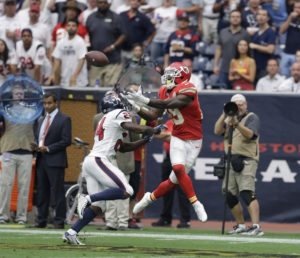KANSAS CITY, Mo. – The NFL can’t escape the debate because controversies are common during the 2015 season.
Active officials apparently can’t agree; retired officials now paid as analyst have varying opinions; former and current players are confused; and fans throw their hands up in frustration over one simple question:

Sept. 13, 2015; Houston; Chiefs wide receiver Jeremy Maclin (19) reaches for a pass over Houston Texans defender Johnathan Joseph (24) during the second half at NRG Stadium. The officials ruled the pass incomplete after determining Maclin didn’t maintain possession when sliding out of bounds. (AP Photo/Patric Schneider)
What in the world constitutes a catch?
“Each play is different, each catch is different and it gets tough sometimes,” Chiefs quarterback Aaron Murray said. “It’s funny, me and some buddies watching the game – Monday Night Football or Thursday Night Football or whatever – and half of us will be saying it’s a catch and half of us will say it’s not a catch. Everyone just looks at it differently.”
The perspectives are at the core of the debate, but help could be on the way to better define the act of plucking an oblong-shaped ball out of the air.
Speaking to reporters Wednesday at the league meetings in Dallas, NFL commissioner Roger Goodell said the Competition Committee has looked into simplifying the rule.
Goodell also took matters a step further.
“A couple of weeks ago I asked several football personnel, including former GMs, current GMs, current individuals, former players, former officials to come together and try to see if we can study this and come up with some proposal for the Competition Committee to consider,” Goodell told reporters. “There are a lot of factors to consider. How it’s officiated, how it’s played, how it’s coached, how the fans react.
“We want clarity to that. We want to find a better solution if it’s out there and so that committee will come back, they will report to the Competition Committee and the Competition Committee will then of course report to the membership if there’s a solution or a recommendation.”
Chiefs offensive coordinator Doug Pederson offered best wishes to the committee on that venture.
“Good luck,” Pederson said with a chuckle.
Pederson has a point, of course. While the task appears easily assigned by Goodell, the undertaking of fixing the rule is far from it when considering the league’s current definition of a catch and the process of completing the action.
Here’s the definition as found in the 2015 NFL Rulebook, cut and pasted verbatim:
A catch is made when a player inbounds secures possession of a pass, kick, or fumble that is in flight (See 8-1-3).
Notes:
(1) It is a catch if, in the process of attempting to catch the ball, a player secures control of the ball prior to it touching the ground, and that control is maintained during and after the ball has touched the ground.
(2) In the field of play, if a catch has been completed, and there is contact by a defender causing the ball to come loose before the player who caught the loose ball is down by contact, it is a fumble, and the ball remains alive. It is also a fumble if the action occurs in the end zone being defended by the team of the player who caught the loose ball. If the action occurs in the opponent’s end zone, it is a touchdown or a touchback.
But wait, there’s more. Much more:
The terms catch, intercept, recover, advance, and fumble denote player possession (as distinguished from touching or muffing).
Notes:
(1) A player who goes to the ground in the process of attempting to secure possession of a loose ball (with or without contact by an opponent) must maintain control of the ball until after his initial contact with the ground, whether in the field of play or the end zone. If he loses control of the ball, and the ball touches the ground before he regains control, there is no possession. If he regains control prior to the ball touching the ground, it is a catch, interception, or recovery. A player is considered to be going to the ground if he does not remain upright long enough to demonstrate that he is clearly a runner.
(2) If a player goes to the ground out of bounds (with or without contact by an opponent) in the process of attempting to secure possession of a loose ball at the sideline, he must maintain complete and continuous control of the ball until after his initial contact with the ground, or there is no possession.
(3) If a player has control of the ball, a slight movement of the ball will not be considered loss of possession. He must lose control of the ball in order to rule that there has been a loss of possession.
For anyone keeping score at home, the rule comes down to a ridiculous 377 words, complete with subsections to define a catch and the process of performing it.
There is also the human element to consider.
“Things happen so fast,” Murray said. “You have to look at a lot things – does he get his feet down, did he drag the feet? And then you have to look to see if he maintained his catch at first or did he bobble it?
“I mean, to be a ref with some of those catches, you have to be able to look at the feet and hands all at once to try and figure it out. It gets tough sometimes. I’m not going to lie, I feel bad for those guys.”
The Chiefs, for the most part, have avoided the controversy entering Week 13’s game against the Oakland Raiders.
And the only time the rule affected the offense came in Week 1 when officials ruled wide receiver Jeremy Maclin didn’t maintain possession after hauling in a 39-yard pass along the sidelines.
Maclin said after the game the league needed to do a seminar on defining a catch, and he didn’t have a firm reaction to the commissioner appointing a committee to clarify matters.
“I really don’t know,” Maclin said with a chuckle.
But he tended to agree the effort to finally address the rule has been long-time coming given the league-wide controversies.
“I guess you can say that, but at the same time you still have to be consistent,” Maclin said. “I think that’s the hardest thing. I think in their minds they got a pretty clear definition of what a catch is. I just think it’s too hard to regulate from officiating crew to officiating crew to whomever is reviewing it in New York or wherever they’re at.”
Maclin has a point, of course, because even former NFL officials now employed as analysts by network TV stations sometimes don’t agree with the active officials.
Consistency is an issue based on interpretation of the rule.
“It just has to be defined whatever it is,” wide receiver Jason Avant said. “It can’t be someone’s interpretation of the rules, which is always going to lead to different scenarios and outcomes. Whatever the rule is now, it’s too vague.”
Ask rookie tight end Brian Parker what is a catch and he offers a prompt response.
“I’ve always been possession, two feet inbounds,” Parker said, “and then you go on about your day.”
Parker’s definition is easy enough and the problem for the committee is offering a solution to the current rule where interpretations overrule what a reasonable person observes.
The committee could start by relying on what the players on the field and even a novice fan already knows.
“At the end of the day, we all pretty much know what a catch is,” Maclin said. “A while ago, it was possession, two feet down to what it is now – it’s maintain control through this and that if the defender does this, all types of stuff. I think maybe if they simplify the rule a little bit, maybe it can help, but at the same time I just think it’s too hard to regulate from crew to crew.”
In the meantime, the Chiefs offensive coordinator has the best approach while the NFL attempts to fix a catch rule that has become a source of contention and confusion.
“Just catch the ball,” Pederson said. “It can be, but again, it’s a discretion, it’s up to the official at the time. We just teach our guys to just maintain possession all the way to the ground and if you just do it right the first time you take that rule out of play.”
———-
Herbie Teope is the lead Chiefs beat writer for ChiefsDigest.com and The Topeka Capital-Journal. Use the contact page to reach him or find him on Twitter: @HerbieTeope.
———-
